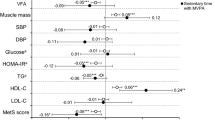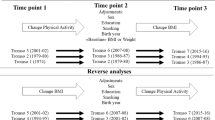Abstract
Background/Objectives:
To analyze whether elderly Iranians in Sweden have a higher mean body mass index (BMI) and are less physically active than elderly Swedes after adjustment for possible confounders.
Subjects/Methods:
A total of 402 men and women (167 Iranian-born and 235 Swedish-born) aged 60–84 years residing in Stockholm, Sweden, were included in this population-based survey. Iranian participants were weighed and their height was measured. BMI values from the Swedish participants were based on self-reported data adjusted for the known discrepancy between objectively measured and self-reported weight and height. The outcome variables, BMI and self-reported leisure-time physical activity, were analyzed by linear regression and unconditional logistic regression.
Results:
Overall, Iranian women had the highest mean BMI (29.2) of all subgroups. The model that included an interaction between sex and length of time in Sweden showed that there was no significant difference in BMI between Swedish men (reference) and Swedish women or Iranian men. In contrast, Iranian women had significantly higher BMI than the reference group after adjustment for age, education and marital status. The largest difference in BMI compared to the reference group was found among Iranian women who immigrated to Sweden in 1989 or later (β-coefficient=3.41, 95% CI=1.99–4.83). Iranians and Swedes had almost the same odds of ⩾ once-weekly leisure-time physical activity.
Conclusions:
Elderly Iranian immigrants and especially women who immigrated to Sweden in 1989 or later must be targeted in order to decrease their burden of risk factors for cardiovascular disease.
This is a preview of subscription content, access via your institution
Access options
Subscribe to this journal
Receive 12 print issues and online access
$259.00 per year
only $21.58 per issue
Buy this article
- Purchase on Springer Link
- Instant access to full article PDF
Prices may be subject to local taxes which are calculated during checkout
Similar content being viewed by others
References
Ahmadi F, Tornstam L (1996). The old flying Dutchmen: shuttling immigrants with double assets. J Aging Identity 1, 191–210.
Arbab-Zadeh A, Dijk E, Prasad A, Fu Q, Torres P, Zhang R et al. (2004). Effect of aging and physical activity on left ventricular compliance. Circulation 110, 1799–1805.
Azizi F (2001). Tehran Lipid and Glucose Study 2001. Study methodology and summarized findings: Endocrine Research Centre, Shaheed Beheshti University of Medical Sciences.
Azizi F, Azadbakht L, Mirmiran P (2005). Trends in overweight, obesity and central fat accumulation among Tehranian adults between 1998–1999 and 2001–2002: Tehran lipid and glucose study. Ann Nutr Metab 49, 3–8.
Beaufrere B, Morio B (2000). Fat and protein redistribution with aging: metabolic considerations. Eur J Clin Nutr 54 (Suppl 3), S48–S53.
Daryani A, Berglund L, Andersson A, Kocturk T, Becker W, Vessby B (2005). Risk factors for coronary heart disease among immigrant women from Iran and Turkey, compared to women of Swedish ethnicity. Ethn Dis 15, 213–220.
Dawson AJ, Sundquist J, Johansson SE (2005). The influence of ethnicity and length of time since immigration on physical activity. Ethn Health 10, 293–309.
Deurenberg P, Yap M, van Staveren WA (1998). Body mass index and percent body fat: a meta analysis among different ethnic groups. Int J Obes Relat Metab Disord 22, 1164–1171.
Ferreira I, Snijder MB, Twisk JW, van Mechelen W, Kemper HC, Seidell JC et al. (2004). Central fat mass versus peripheral fat and lean mass: opposite (adverse versus favorable) associations with arterial stiffness? The Amsterdam Growth and Health Longitudinal Study. J Clin Endocrinol Metab 89, 2632–2639.
Gadd M, Johansson SE, Sundquist J, Wandell P (2003). Morbidity in cardiovascular diseases in immigrants in Sweden. J Intern Med 254, 236–243.
Galanos AN, Pieper CF, Cornoni-Huntley JC, Bales CW, Fillenbaum GG (1994). Nutrition and function: is there a relationship between body mass index and the functional capabilities of community-dwelling elderly? J Am Geriatr Soc 42, 368–373.
Ghassemi H, Harrison G, Mohammad K (2002). An accelerated nutrition transition in Iran. Public Health Nutr 5, 149–155.
Groessl EJ, Kaplan RM, Barrett-Connor E, Ganiats TG (2004). Body mass index and quality of well-being in a community of older adults. Am J Prev Med 26, 126–129.
Gu D, He J, Duan X, Reynolds K, Wu X, Chen J et al. (2006). Body weight and mortality among men and women in China. JAMA 295, 776–783.
Haapanen-Niemi N, Miilunpalo S, Pasanen M, Vuori I, Oja P, Malmberg J (2000). Body mass index, physical inactivity and low level of physical fitness as determinants of all-cause and cardiovascular disease mortality—16 y follow-up of middle-aged and elderly men and women. Int J Obes Relat Metab Disord 24, 1465–1474.
Harris TB, Launer LJ, Madans J, Feldman JJ (1997). Cohort study of effect of being overweight and change in weight on risk of coronary heart disease in old age. BMJ 314, 1791–1794.
Heiat A, Vaccarino V, Krumholz HM (2001). An evidence-based assessment of federal guidelines for overweight and obesity as they apply to elderly persons. Arch Intern Med 161, 1194–1203.
Hosmer DW, Lemeshow S (1989). Applied Logistic Regression. Wiley: New York.
Johansson SE, Sundquist J (1999). Change in lifestyle factors and their influence on health status and all-cause mortality. Int J Epidemiol 28, 1073–1080.
Jonnalagadda SS, Diwan S (2005). Health behaviors, chronic disease prevalence and self-rated health of older Asian Indian immigrants in the US. J Immigr Health 7, 75–83.
Kuskowska-Wolk A, Rossner S (1989). The ‘true’ prevalence of obesity. A comparison of objective weight and height measures versus self-reported and calibrated data. Scand J Prim Health Care 7, 79–82.
Kuskowska-Wolk A, Karlsson P, Stolt M, Rossner S (1989). The predictive validity of body mass index based on self-reported weight and height. Int J Obes 4, 441–453.
Launer LJ, Harris T, Rumpel C, Madans J (1994). Body mass index, weight change, and risk of mobility disability in middle-aged and older women. The epidemiologic follow-up study of NHANES I. JAMA 271, 1093–1098.
Lawlor DA, Bedford C, Taylor M, Ebrahim S (2002). Agreement between measured and self-reported weight in older women. Results from the British Women's Heart and Health Study. Age Ageing 3, 169–174.
Lindstrom M, Sundquist K (2005). The impact of country of birth and time in Sweden on overweight and obesity: a population-based study. Scand J Public Health 33, 276–284.
Maddah M, Eshraghian MR, Djazayery A, Mirdamadi R (2003). Association of body mass index with educational level in Iranian men and women. Eur J Clin Nutr 57, 819–823.
Martorell R, Khan LK, Hughes ML, Grummer-Strawn LM (2000). Obesity in women from developing countries. Eur J Clin Nutr 54, 247–252.
McKie L, MacInnes A, Hendry J, Donal S, Peace H (2000). The food consumption patterns and perceptions of dietary advice of older people. J Hum Nutr Diet 13, 173–183.
Mendez MA, Popkin BM (2004). Globalisation, urbanisation and nutritional changes in the developing world. Electron J Agric Dev Econ 1, 220–241.
Mirmiran P, Esmaillzadeh A, Azizi F (2004). Detection of cardiovascular risk factors by anthropometric measures in Tehranian adults: receiver operating characteristic (ROC) curve analysis. Eur J Clin Nutr 58, 1110–1118.
Mirmiran P, Mohammadi F, Sarbazi N, Allahverdian S, Azizi F (2003). Gender differences in dietary intakes, anthropometrical measurements and biochemical indices in an urban adult population: the Tehran Lipid and Glucose Study. Nutr Metab Cardiovasc Dis 13, 64–71.
Mykkanen L, Laakso M, Pyorala K (1992). Association of obesity and distribution of obesity with glucose tolerance and cardiovascular risk factors in the elderly. Int J Obes Relat Metab Disord 16, 695–704.
Nazroo JY (2003). The structuring of ethnic inequalities in health: economic position, racial discrimination, and racism. Am J Public Health 93, 277–284.
Pan WH, Flegal KM, Chang HY, Yeh WT, Yeh CJ, Lee WC (2004). Body mass index and obesity-related metabolic disorders in Taiwanese and US whites and blacks: implications for definitions of overweight and obesity for Asians. Am J Clin Nutr 79, 31–39.
Persson D, Olsson C (2006). Yearbook of agricultural statistics 2006, including food statistics. Statistics Sweden: Sweden.
Pudaric S, Sundquist J, Johansson SE (2000). Major risk factors for cardiovascular disease in elderly migrants in Sweden. Ethn Health 5, 137–150.
Rashidi A, Mohammadpour-Ahranjani B, Vafa MR, Karandish M (2005). Prevalence of obesity in Iran. Obes Rev 6, 191–192.
Spiegelman D, Israel RG, Bouchard C, Willett WC (1992). Absolute fat mass, percent body fat, and body-fat distribution: which is the real determinant of blood pressure and serum glucose? Am J Clin Nutr 55, 1033–1044.
StataCorp (2001). Stata Statistical Software. Stata Press: Texas.
Statistics Sweden (2006). Foreign-born persons in Sweden by country of birth, age and sex. Year 2000–2005http://www.ssd.scb.se/databaser/makro/Produkt.asp?produktid=BE0101(In Swedish: Utrikes födda i riket efter födelseland, ålder och kön. År 2000–2005).
Stewart A (1982). The reliability and validity of self-reported weight and height. J Chronic Dis 4, 295–309.
Stunkard AJ, Albaum JA (1981). The accuracy of self-reported weights. Am J Clin Nutr 34, 1593–1599.
Sundquist J (1994). Migration and health.Epidemiological studies in Swedish primary health care. University of Lund: Sweden.
Sundquist J, Winkleby M (2000). Country of birth, acculturation status and abdominal obesity in a national sample of Mexican-American women and men. Int J Epidemiol 29, 470–477.
Sundquist J, Winkleby MA, Pudaric S (2001). Cardiovascular disease risk factors among older black, Mexican-American, and white women and men: an analysis of NHANES III, 1988–1994. Third National Health and Nutrition Examination Survey. J Am Geriatr Soc 49, 109–116.
Visser M, Langlois J, Guralnik JM, Cauley JA, Kronmal RA, Robbins J et al. (1998). High body fatness, but not low fat-free mass, predicts disability in older men and women: the Cardiovascular Health Study. Am J Clin Nutr 68, 584–590.
Wärneryd B (1991). Levnadsförhållanden. Aterintervjustudie i undersökningen av levnadsförhållanden 1989 (ULF). Living conditions. Reinterview in ULF 1989. Appendix 12: Statistics Sweden.
Willett WC, Dietz WH, Colditz GA (1999). Guidelines for healthy weight. N Engl J Med 341, 427–434.
Acknowledgements
This work was supported by grants from the Swedish Council for Working Life and Social Research (Grant no. 2001-2373), the Swedish Research Council (Grant no. K2004-21X-11651-09A), the National Institutes of Health (1 R01 HL71084-01), the Swedish Research Council to Dr Kristina Sundquist (K2005-27X-15428-01A) and ALF projektmedel, Stockholm.
Author information
Authors and Affiliations
Corresponding author
Additional information
Guarantor: J Sundquist.
Contributors: AK conceived the study, collected the data, performed the analysis and wrote the first draft; S-EJ supervised the data analysis; TOK and JS supervised the data collection and data management. All authors contributed to the data interpretation and the final draft.
Rights and permissions
About this article
Cite this article
Koochek, A., Johansson, SE., Kocturk, T. et al. Physical activity and body mass index in elderly Iranians in Sweden: a population-based study. Eur J Clin Nutr 62, 1326–1332 (2008). https://doi.org/10.1038/sj.ejcn.1602851
Received:
Revised:
Accepted:
Published:
Issue Date:
DOI: https://doi.org/10.1038/sj.ejcn.1602851
Keywords
This article is cited by
-
The prevalence of obesity in older adults in Iran: a systematic review and meta-analysis
BMC Geriatrics (2019)
-
The ethnic gap in mobility: a comparison of Russian, Somali and Kurdish origin migrants and the general Finnish population
BMC Public Health (2016)
-
The association between mental health symptoms and mobility limitation among Russian, Somali and Kurdish migrants: a population based study
BMC Public Health (2015)



